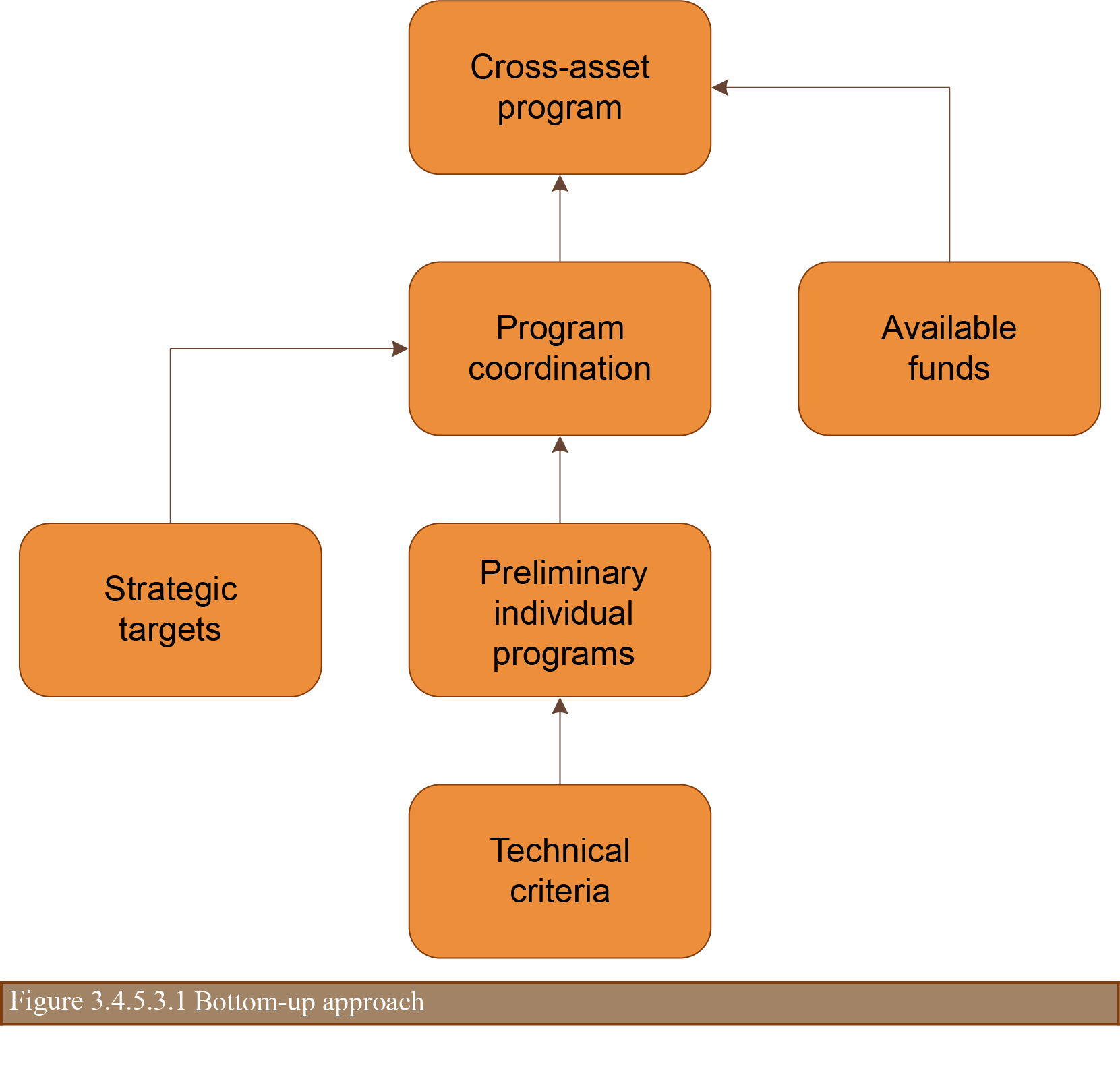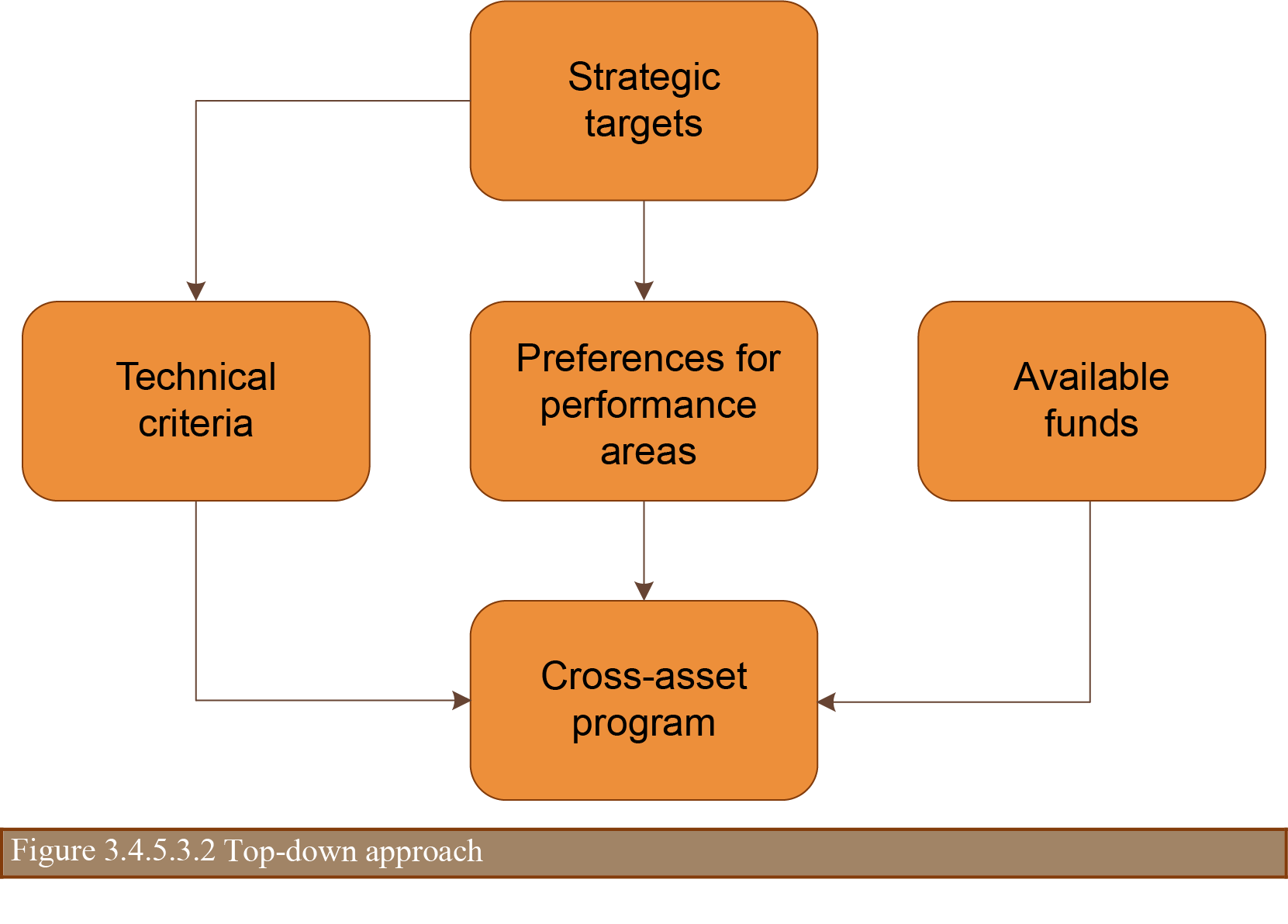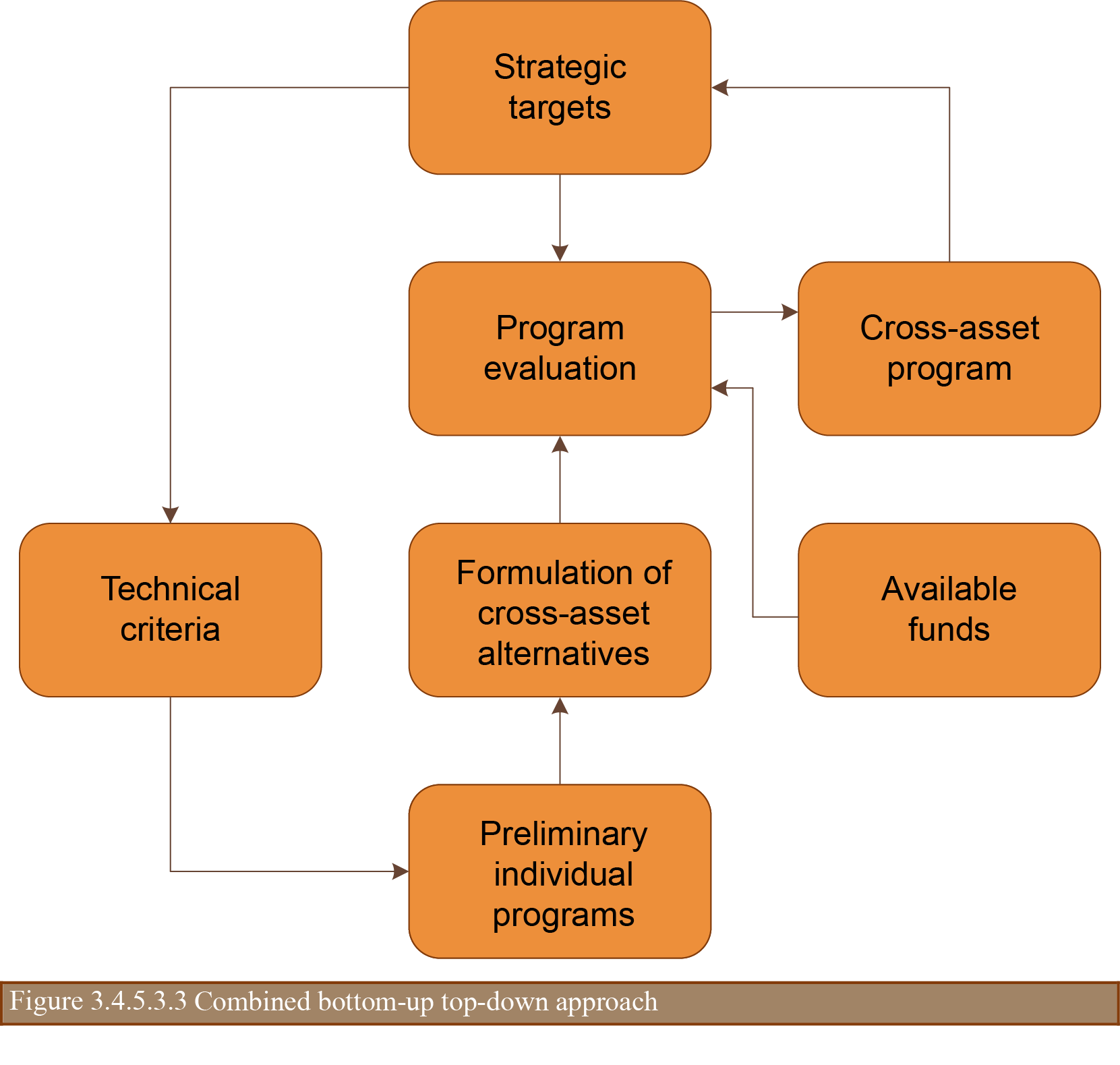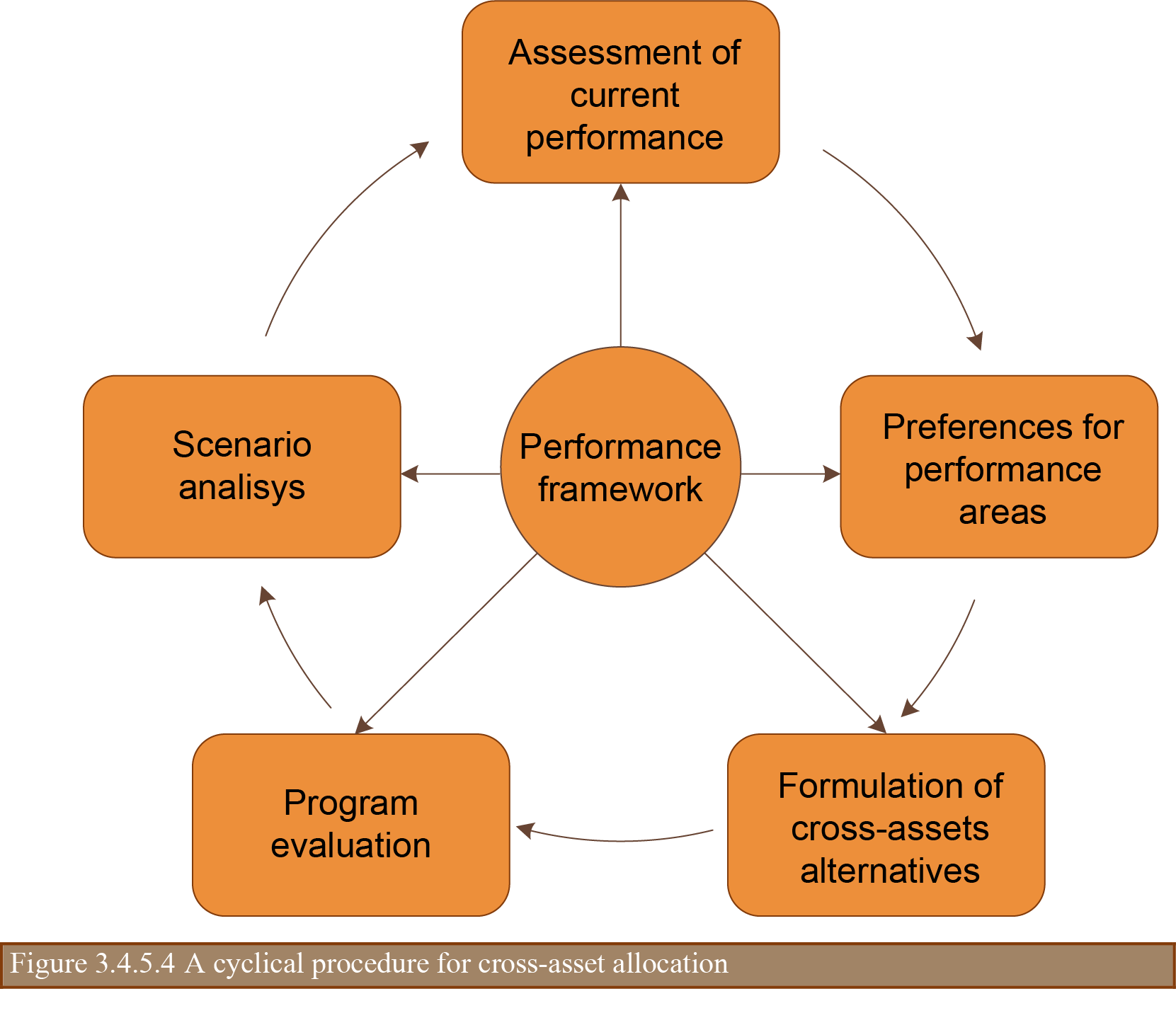

Paragraph 3.4.4.3 introduces cross-asset allocation as a means of distributing resources among asset classes during the optimization of multi-year works programs. Actually, from a conceptual point of view, cross-asset allocation constitutes a complete programming approach on its own that makes use of advanced asset management components such as strategy, performance and risk. The following paragraphs discuss the concept of cross-asset allocation, and its potential as an effective tool for achieving the strategic goals of road organizations. Also, a procedure based on the international experience in applying this approach is outlined.
Cross-asset allocation involves the distribution of resources among road investment programs in order to realize the strategic objectives of the organization responsible (see paragraph 1.4.4.1). An investment program may refer to any works program intended to maintain or improve asset condition, but also to impact other performance areas such as safety, mobility or sustainability. In general, road attributes modifiable through investment programs may be designated as “drivers for renewal / maintenance” (AM4INFRA 2019).
The allocation of resource among investment programs is a complex task that starts with determining optimal solutions for single assets / operational issues. Many organizations have implemented advanced management systems for pavements, bridges and road safety, but only a few of them have appropriate tools for other areas. Since asset management implies assessing the level of service of a road network as a whole, the next step should be allocating constrained resources across the various investment programs. A question immediately arises: what (consistent) measures should be used to compare the benefits of the different programs among them?
During the 2009-2012 cycle, the PIARC technical committee on asset management carried out a study to identify the main approaches used by member countries to allocate resources among different assets (PIARC 2012-b). The study showed that the most common distribution method remained a percentage split of budget based on historical allocation. Nevertheless, road organizations already had envisaged the future use of more formal methods such as risk ranking, comparison of economic indicators (NPV, BCR and IRR), and multicriteria analysis.
Later on, the implementation of holistic asset management in a number of countries worldwide, led to the application of increasingly sophisticated procedures for coordinating, prioritizing and optimizing all maintenance activities on the different asset classes, as found by PIARC technical committee on asset management that worked through the 2013-2015 cycle (PIARC 2016). The study carried out by this committee quotes a Trans-European ENR research project known as PROCROSS, which identified three basic approaches to cross-asset allocation used in European countries (ENR 2012): bottom-up, top-down, and a combination of these. According to the project, all three approaches are valid and consistent in finding an optimum solution based on existing preconditions
A general description of the approaches identified by PROCROSS is presented in paragraph 3.4.5.3.
As pointed out in section 1.2, many road organizations around the world still operate under a silo-like structure, in which the various physical and operational issues like pavement condition or mobility are managed separately with a limited consideration of the organization strategic objectives.
Adverse effects of the traditional practice include (Deix, Alten, & Weninger-Vycudil, 2012):
Cross-asset allocation has been conceived to overcome disadvantages such as the above. In contrast with traditional methods, a cross-asset approach provides means for analyzing concurrently the benefits from different investment alternatives for each asset / operational issue so that the strategic objectives are attained more effectively and efficiently.
As mentioned previously, the ENR PROCROSS project identified the following approaches to cross-asset allocation as part as the asset management practice in Europe:
Bottom-up approach. This first method, portrayed in figure 3.4.5.3.1, is strongly influenced by the technical assessment of individual groups of assets / projects. Usually, each single group is analyzed separately by specific management systems that facilitate selection of appropriate alternatives under a certain number of given monetary or non-monetary preconditions.

The cross-asset process is usually not carried out at this application level, but the results can be used in a subsequent process of “coordination” across the individual groups. This process recalls the strategic objectives and targets, and may alter significantly the technically optimal solutions originally found.
The comprehensive appraisal of asset technical need constitutes the main advantage of the bottom-up approach. However, this feature represents also its main weakness since the focus on technical aspects leave the strategic objectives only rudimentarily considered.
Top-down approach. According to PROCROSS definitions, a top-down approach (Figure 3.4.5.3.2) is based on high-level, central decisions that consider the road network as a whole. It assumes that the overall performance of the network can be improved if its various assets / attributes are addressed concurrently rather than on a single basis.

The application of a top-down approach requires a deep understanding of the performance of the network, in order to give preference to those programs that better contribute to achieve the desired or feasible strategic targets.
A top-down approach provides clear and comprehensive criteria for analyzing assets at the technical level. However, this does not imply that engineering considerations are applied to the necessary extent, which increment risks related to achieving the levels of service pursued.
Combined approach. A combined bottom-up top-down approach, as represented in figure 3.4.5.3.3, entails the evaluation of the technical results of single assets in terms of the organization’s strategic targets. A critical issue for this approach is conciliating the strategic and the engineering requirements.

In the combined approach, the cross-asset allocation process usually occurs at an intermediate level between the strategic and the project levels. Under this approach, one the main objectives of works programming consists in harmonizing the strategic targets and the technical specifications by finding an optimal point that maximizes the fulfillment of the strategic objectives while reducing as much as possible the risk associated with the actual level of service provided. This is not an easy task as projects often do not comply with strategic criteria because they come as a result of a prioritization / optimization process that relies mainly on simple ranking and not from a network-wide performance analysis.
The final report of the PROCROSS project (ENR 2012) includes a specific cross-asset allocation procedure, which is based in the combined approach described above and comprises the following activities:
A procedure for cross-asset allocation is also provided in the Report 806 of the US National Cooperative Highway Research Program (Maggiore, Ford, CH 2M Hill, High Street Consulting Group & Burns & McDonell, 2015). In this case, the procedure is made up of the tasks below:
Form the above listings, it can be concluded that both procedures are quite similar, even though the PROCROSS method do not include a step for comparing the effects of funding levels.
A further procedure for cross-asset allocation is presented next. Although, on the one hand, this procedure is based on the two methods outlined previously, on the other hand it assumes that the organization has developed a performance framework (see section 1.4) so the following items are already available:
Given the above, a cyclical procedure for cross-asset allocation can be depicted as shown in Figure 3.4.5.4.

The steps illustrated in this figure can be described as follows:
Assessment of current performance. It implies determining the organization progress in reaching the strategic targets defined within the performance framework. Any difference will represent a performance gap that has to be addressed through the proposed investment programs.
Development of individual programs. Works dealing with improving the condition of individual assets or any other attribute of the road network are identified in this step using specialized management systems for each asset / operational issue (pavements, bridges, safety, etc.) The resulting programs are intended to minimize the risk of not achieving the targets proposed for each performance area.
Formulation of cross-asset alternatives. Combines the projects selected for the individual programs in order to cover all performance areas with a single works program. Also, define alternative programs containing project options different from those selected in the previous step so that the preferences stated in the performance framework can be considered while carrying out cross-asset allocation under budget constraints.
Program evaluation. Refers to a decision-making process that should be applied to identify, using diverse criteria, the alternative of a cross-asset program that best contributes to attaining the targets specified in the performance framework. This involves comparing projects in terms of their benefits, which are normally expressed in different units depending on the performance area addressed by each project. Thus, all benefits should be normalized (i.e. converted to a common metric) to allow for comparison.
The international experience on cross-asset works programming comprise the application of decision-making techniques such as the following (Proctor & Zimmerman, 2016; Porras-Alvarado, Han, & Zhang, 2014):
The multi-criteria analysis may provide various advantages. First, the analyst priorities are specifically declared through the assignment of weights to the different performance areas. At the same time, the decision maker objectives are clarified while translating them into criteria for evaluating intervention alternatives. Furthermore, the system for evaluating alternatives is transparent since it leaves a clear record of the weights and criteria applied. Finally, the multi-criteria analysis is flexible as it permits criteria to be added as well as disparate criteria to be used.
However, it also has disadvantages: i) Costs and risks are not explicitly involved in the analysis; ii) Results are very sensitive to the values attributed to weights, so these can be determinant of the alternatives selected.
Cross-asset optimization involves the use of recursive mathematical procedures to find the maximum level of benefits that can be produced by a given set of investments subject to technical performance requirements and budget constraints. Its application implies the use of a software capable of evaluating a considerable number of options (hundreds or even thousands) to find the one yielding the greatest benefits. It this way, cross-asset optimization generates more sophisticated and quantified results, yet it requires extensive data about all candidate projects evaluated.
Scenario analysis. This last step is equivalent to the last step of the cross-asset allocation procedure proposed in the US NHCRP Report 806 (Maggiore, Ford, CH 2M Hill, High Street Consulting Group, & Burns & McDonell, 2015). As the latter, it consists of determining the effects of various investment scenarios and funding levels in the performance of the road network both as a whole and considering each individual asset / operational feature individually. The results of such an analysis can be used to identify the needs of stakeholders concerning the different performance areas and the budgeting required to meet those requirements, and eventually to modify appropriately the performance targets in use.
Finally, it should be noted that the procedure described above is based on the combined approach for cross-asset allocation portrayed in figure 3.4.5.3.3, as it starts with the individual analysis of each of the different performance areas, and then it combines candidate projects from the different programs to obtain a solution oriented towards achieving the performance goals of the road organization.